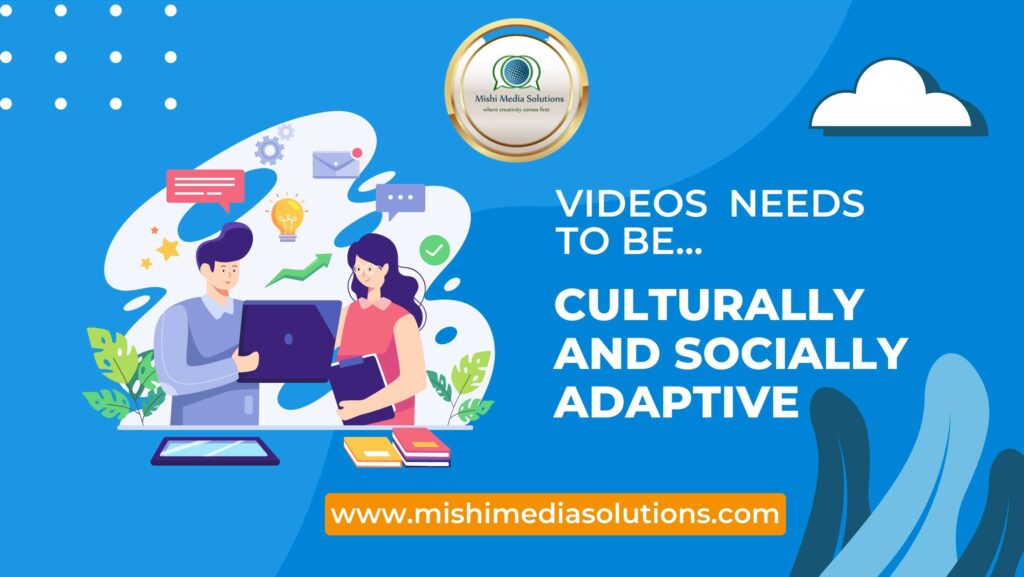
Videos needs to be culturally and socially acceptable
When it comes to marketing in India, understanding the cultural sensitivities and preferences of the audience is crucial for creating impactful and successful campaigns. India is a diverse country with rich cultural heritage, languages, traditions, and beliefs.
See this one of our Latest Work
CALL NOW: 9549700549
In this article, we will delve into the nuances of the Indian audience, explore their cultural sensitivities, and highlight their preferences, providing valuable insights for businesses to effectively connect with the Indian market.
Cultural Diversity in India: India is known for its cultural diversity, with different regions having distinct languages, customs, festivals, and traditions. It’s essential to acknowledge and respect this diversity while crafting marketing messages. Consider tailoring your content to resonate with specific regional audiences, using local languages, and incorporating elements of regional culture to establish a deeper connection.
Respect for Traditions and Values: Indian society holds strong values and traditions that are deeply ingrained in its culture. Businesses should be mindful of these values and portray them in a positive light in their marketing efforts. Showcasing respect for elders, family values, and traditions can help build trust and credibility among the Indian audience.
Festivals and Celebrations: Festivals hold significant importance in India, and they present excellent opportunities for businesses to connect with the audience. Diwali, Holi, Eid, Christmas, and various regional festivals are celebrated with enthusiasm across the country. Tailor your marketing campaigns to coincide with these festivals, offering special promotions, discounts, or themed content to engage with consumers during these festive periods.
Language Considerations: India is a linguistically diverse country, with multiple languages spoken across different states. While English is widely understood, it’s important to cater to regional language preferences. Consider translating and localizing your content to reach a broader audience. This demonstrates a commitment to understanding and connecting with the local culture and can greatly impact the success of your marketing efforts.
Music, Films, and Pop Culture: Music and films play a significant role in Indian culture, and they hold immense popularity among the audience. Incorporating music or references to popular films and celebrities in your marketing campaigns can help create an emotional connection and resonate with the Indian audience. Stay updated on the latest trends in Indian pop culture to effectively leverage them in your marketing strategies.
Social Consciousness and Causes: Indian consumers are increasingly conscious of social issues and are drawn to brands that align with their values. Incorporating social causes and responsible messaging in your marketing campaigns can create a positive perception and enhance brand loyalty. Showcasing initiatives related to education, environment, women empowerment, or rural development can resonate well with the Indian audience.
Digital Adoption and Mobile Usage: India has witnessed a rapid increase in digital adoption, with a large number of users accessing the internet through mobile devices. Optimize your marketing campaigns for mobile platforms, ensuring that your content is mobile-friendly and compatible with varying internet speeds. Utilize mobile apps, social media platforms, and messaging apps to reach and engage with the Indian audience effectively.

Example Scenario: “Festival-Focused E-Commerce Campaign”
Objective: An e-commerce platform aimed to connect with the Indian audience during a major festival season.
Understanding Cultural Sensitivities:
Religious Diversity:
Recognized and respected the diverse religious backgrounds of the audience, ensuring content was inclusive and non-denominational.
Traditional Attire Consideration:
Acknowledged the significance of traditional attire during festivals, featuring models showcasing diverse clothing styles representative of different regions.
Language Inclusivity:
Offered content in multiple languages, respecting linguistic diversity and ensuring accessibility to a broader audience.
Preferences in Action:
Personalized Recommendations:
Utilized data on previous purchase behaviors during festivals to provide personalized product recommendations aligned with individual preferences.
Interactive Content:
Introduced interactive elements like quizzes and polls related to festival traditions, encouraging audience participation and fostering a sense of community.
Social Impact Initiatives:
Integrated social responsibility initiatives aligned with festival themes, resonating with the audience’s preference for brands contributing to social causes.


